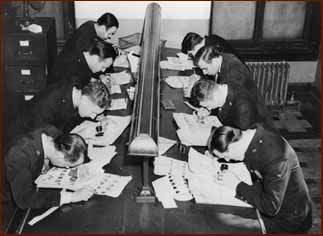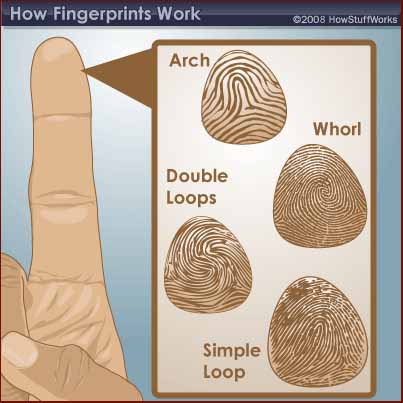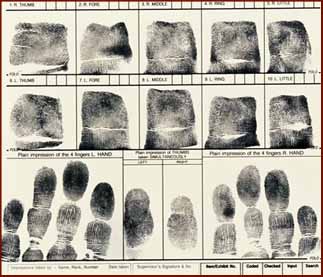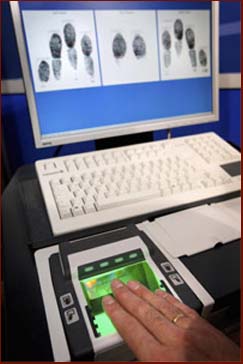
How Fingerprinting Works!

MAY 26, 2008
How Fingerprinting Works
Fingerprinting has been used for more than a century: what are the basic characteristics?
Author: Stephanie Watson
A woman has been murdered. When the detectives arrive on the scene, the house is in shambles. Clothes are strewn about the floor, lamps are overturned and there's no sign of the assailant. Then, one of the detectives picks up a glass. On its side is a smudged, bloody thumbprint. He takes it down to the lab, where it's analyzed and matched to a recorded set of prints. The detectives catch their killer.

This scene has been replayed in one crime drama after another. Ever since scientists discovered that every person's fingerprints are unique, and police officers realized this singularity could help them catch criminals, fingerprints have been an integral part of the law enforcement process. Today, fingerprints are also used to prevent forged signatures, identify accident victims, verify job applicants and provide personalized access to everything from ATMs to computer networks.
But fingerprinting has come a long way from the days when police officers lifted prints from a crime scene and checked them manually against their files.
Modern fingerprinting techniques can not only check millions of criminal records simultaneously, but can also match faces, backgrounds and other identifiable characteristics to each perpetrator.

What are the basic characteristics of a fingerprint? How long have people been using prints as a form of identification?
What are fingerprints?
Fingerprints are the tiny ridges, whorls and valley patterns on the tip of each finger. They form from pressure on a baby's tiny, developing fingers in the womb. No two people have been found to have the same fingerprints -- they are totally unique. There's a one in 64 billion chance that your fingerprint will match up exactly with someone else's.
Fingerprints are even more unique than DNA, the genetic material in each of our cells. Although identical twins can share the same DNA -- or at least most of it -- they can't have the same fingerprints.
Fingerprinting is one form of biometrics, a science that uses people's physical characteristics to identify them. Fingerprints are ideal for this purpose because they're inexpensive to collect and analyze, and they never change, even as people age.
Although hands and feet have many ridged areas that could be used for identification, fingerprints became a popular form of biometrics because they are easy to classify and sort. They're also accessible.
Fingerprints are made of an arrangement of ridges, called friction ridges. Each ridge contains pores, which are attached to sweat glands under the skin. You leave fingerprints on glasses, tables and just about anything else you touch because of this sweat.
All of the ridges of fingerprints form patterns called loops, whorls or arches:
• Loops begin on one side of the finger, curve around or upward, and exit the other side. There are two types of loops: Radial loops slope toward the thumb, while ulnar loops slope toward the little finger.
• Whorls form a circular or spiral pattern.
• Arches slope upward and then down, like very narrow mountains.
Scientists look at the arrangement, shape, size and number of lines in these fingerprint patterns to distinguish one from another.
They also analyze very tiny characteristics called minutiae, which can't be seen with the naked eye.
You'll see in many modern-day movies or television shows like 24, where people use body parts to overcome and bypass biometric security. With our product you're looking at moving the deoxidized hemoglobin that's moving through the vein pattern. You have a near-infrared signal that comes up from a sensor; it reflects off of the hand. The blue blood that's moving without oxygen through your hand actually absorbs the light and what's emitted back is the pattern, the vein pattern. It absorbs that light that's emitted from the sensor.

The Fingerprinting Process
The technique of fingerprinting is known as dactyloscopy. Until the advent of digital scanning technologies, fingerprinting was done using ink and a card.
To create an ink fingerprint, the person's finger is first cleaned with alcohol to remove any sweat and dried thoroughly. The person rolls his or her fingertips in ink to cover the entire fingerprint area. Then, each finger is rolled onto prepared cards from one side of the fingernail to the other. These are called rolled fingerprints. Finally, all fingers of each hand are placed down on the bottom of the card at a 45-degree angle to produce a set of plain (or flat) impressions. These are used to verify the accuracy of the rolled impressions.
Today, digital scanners capture an image of the fingerprint. To create a digital fingerprint, a person places his or her finger on an optical or silicon reader surface and holds it there for a few seconds. The reader converts the information from the scan into digital data patterns. The computer then maps points on the fingerprints and uses those points to search for similar patterns in the database.
Law enforcement agents can analyze fingerprints they find at the scene of a crime. There are two different types of prints:
• Visible prints are made on a type of surface that creates an impression, like blood, dirt or clay.
• Latent prints are made when sweat, oil and other substances on the skin reproduce the ridge structure of the fingerprints on a glass, murder weapon or any other surface the perpetrator has touched. These prints can't be seen with the naked eye, but they can be made visible using dark powder, lasers or other light sources. Police officers can "lift" these prints with tape or take special photographs of them.
When did this basic form of identification become a law enforcement staple? How did Babylonians and the ancient Chinese use fingerprints? Go to the next section to find out.
|
CAN YOUR FINGERPRINTS BE CHANGED ... OR STOLEN?
A minor scrape, scratch or even burn won't affect the structure of the ridges in your fingerprints -- new skin reforms in its original pattern as it grows over the wound. But each ridge is also connected to the inner skin by small projections called papillae. If these papillae are damaged, the ridges are wiped out and the fingerprint destroyed.
|
